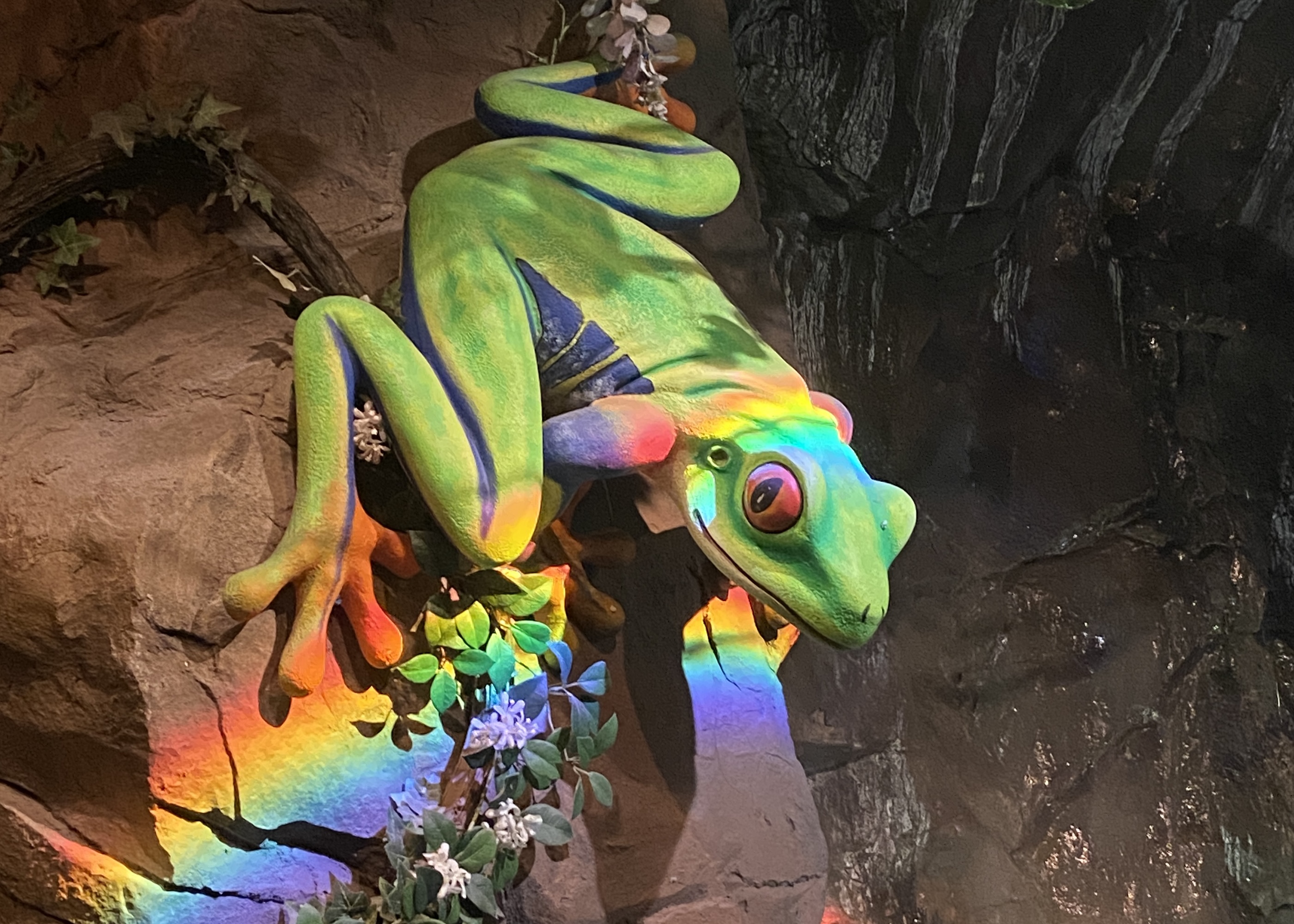A RAINFOREST, New Jersey — Last week in Atlantic City, amid discussions of business, enterprise, and strategy, nearly half of the Defector staff convened for fine dining at the exclusive, Michelin-snubbed establishment that is the Rainforest Cafe. Sean, Justin, and I had the unique privilege of shepherding Ray into his first-ever Rainforest Cafe experience, which quickly catapulted him into an abyssal state of misery that persisted despite a glass of the Rainforest Cafe house red. But that is not what I am here to discuss. I am here to discuss the creatures.
As soon as I glimpsed the dark tunnel of vines that connects the Rainforest Cafe gift shop to the Rainforest Cafe restaurant, a threshold I had not crossed since my halcyon days, a question began buzzing in my mind: Which rainforest is the Rainforest Cafe supposed to be? Of course, the most obvious candidate would be the Amazon, the world's only A-List rainforest. But I also suspected that Rainforest Cafe may be a product of its time and represent not one particular biome, but rather a melange of all rainforests—the high-concept restaurant equivalent of a Coexist decal.
We were seated at the red-hot center of a nearly empty Rainforest Cafe, where I was able to observe and photograph the local animatronic wildlife alongside the final act of a child's birthday party. The most prominently displayed animals all were unmistakable for any other species: gorilla, elephant, red-eyed tree frog, etc. But the closer I looked, some brambles of jungle leaves held birds whose species I could not name off the top of my head. Red parrot? Green parrot? In the real world, when I am confronted with a species I cannot identify, I turn to iNaturalist—a free app that can identify basically any species, provided your photo of it is not too shitty. After you upload a photo of an organism on iNaturalist, the app will either identify it to a species level or provide a list of species or taxa it might be. I wondered how might the trusty animatronics of the Rainforest Cafe fare against iNaturalist AI. Could they help me identify the elusive biome of the Rainforest Cafe?
To start, I uploaded perhaps the easiest-to-identify animal I spotted at the Cafe: the lioness staring out from the door of the women's restroom. I assumed this would be a snap for iNaturalist, as it is not a creaky animatronic from the '90s but a photograph.

Sure enough, iNaturalist was spot-on. Even if it did not definitively identify this Queen as a lion, the app correctly places her in the genus Panthera, and the top suggestion was ultimately correct. Well done, iNaturalist. As soon as I uploaded this photo, however, I realized that lions do not live in the rainforest. They live in the savannahs and grasslands of Africa and India. But I don't think I can use these lions as a clue of the Rainforest Cafe biome, as they were not nestled in the leaves but relegated to the doors of the restrooms, perhaps as a nod towards the diversity of biomes that exist in the world. Time to move on!
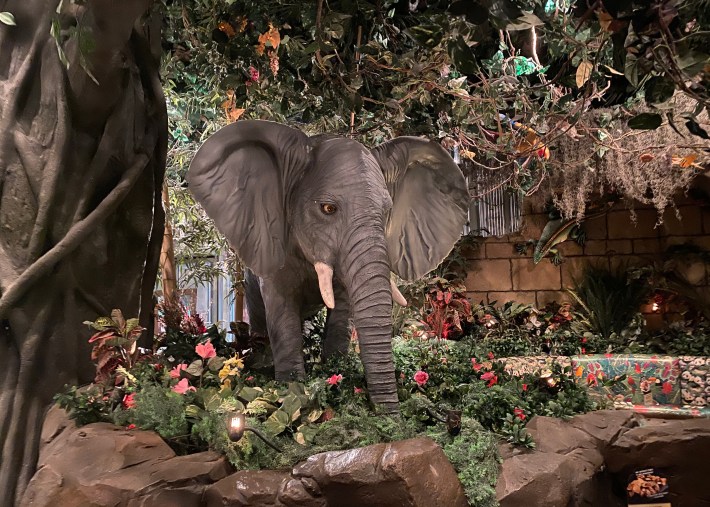
iNaturalist was "pretty sure" this animal was in the family Elephantidae. But iNaturalist could not tell me if this was an African bush elephant, an African savanna elephant, or an Asian elephant. I knew the size and shape of the ears meant this elephant was not Asian. And after a quick google, I deduced that this elephant's straight, downward-pointing tusks could only belong to an African forest elephant, which lives in humid tropical forests. Kudos to the Rainforest Cafe for correctly sculpting the only elephant in the world that actually does live in a rainforest. So far, early signs suggest that the rainforest of the Rainforest Cafe rests somewhere in Africa. Let's move on!
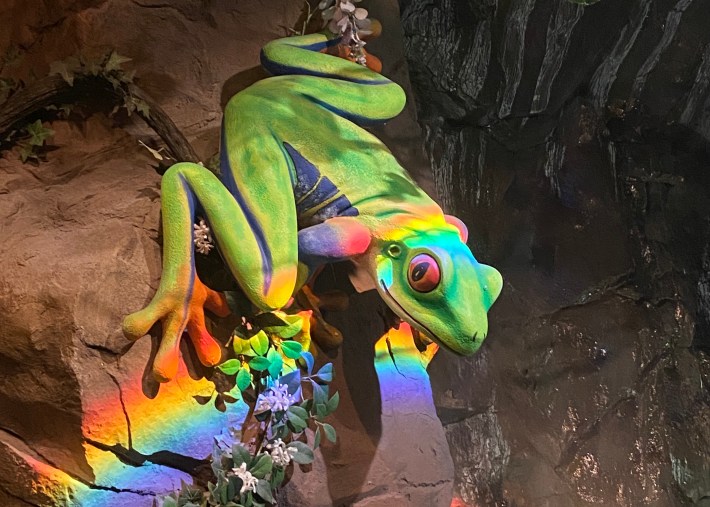
Although there are more than 7,000 species of frog in the world, many of them green, you do not need to be a herpetologist to know that this is a red-eyed tree frog. They may be the most famous frog in the world, at least to kids who grew up in the early aughts, and one individual frog named Cha Cha is the restaurant's mascot. iNaturalist was not confident enough to make its own identification, but its first two suggestions were of a blue-sided leaf frog and a red-eyed tree frog. I'll admit that the blue-sided leaf frog looks pretty similar; its eyes are not red, but perhaps the confusion can be chalked up to that beautiful streak of rainbow draped over the frog. More crucially, however, the red-eyed tree frog lives in forests from Central America to South America, meaning that this Rainforest Cafe's rainforest spans at least two continents. How very cosmopolitan.

I suspected this photo would be a challenge for iNaturalist, as it contains at least four visually distinct birds, and I was right. The app did not identify them, but suggested they may be any number of birds, including the red-breasted toucan and the channel-billed toucan. It was clear from the photos on the app that neither of these toucan identifications were correct, so I set out to identify them on my own, which led me to the realization that there are 43 living species of toucans in the world. Can you believe it? I don't know how many species of toucans I thought there were, but it was surely not 43, so this kind of abundance made me feel like I had won the jackpot in Atlantic City. As I scrolled through headshots of the 43 toucans, they began to blend together in my mind. None of the fake toucans mapped exactly onto the real toucans, making me second-guess my identifications. Was this simply sloppy character design, or was I missing another, more elusive toucan that might be a perfect match to the toucan before me?
No matter. I had only so much time to identify the toucans before this blog would be embarrassingly late. I feel fairly certain that the toucan on the right is a toco toucan and the second toucan from the bottom is a keel-billed toucan. The toucan on the top? Could not say. Is the toucan on the bottom even a toucan? I have to move on.
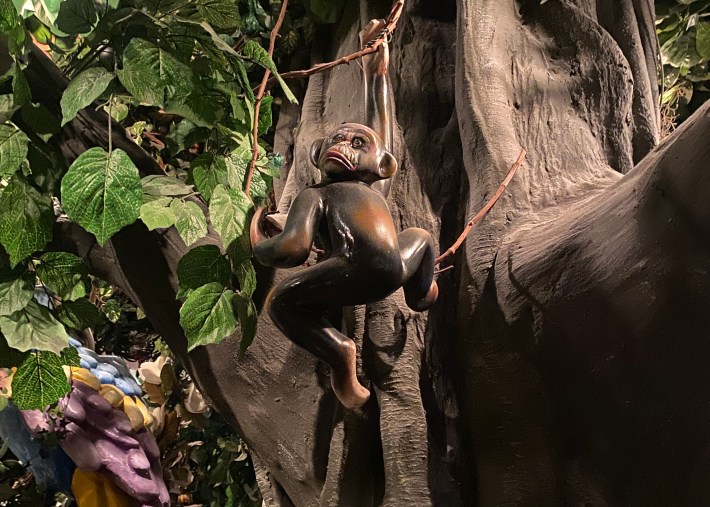
This monkey-like creature was one of the saddest animals at the Rainforest Cafe, and one whose expression I think accurately captures my feeling every time I walked through the smoking section of the slots at our hotel. The Rainforest Cafe was full of primates, many dangling off vines, all of whom seemed quite pleased. But not this little buddy. This primate stared out over our table with its bleak, frozen little face, unmoved by the various lightning storms that came to pass during our dinner. I was perturbed by the details of its body, how the intricately painted grooves on its face gave way to block-like Barbie hands. Was this primate hung on the vine before it was finished? Is that why it looks so distraught? iNaturalist did not dare to identify this particular animal, but suggested it could be a western red colobus, a chimpanzee, or a red-handed howler monkey.
I agree that it could have been any number of primates. Which of these animals would be the most upset to find themselves at a Rainforest Cafe? Perhaps all of them. I was glad my seat did not face this monkey, or else I might have been sucked into its miserable orbit, ruining the joyous mood of dinner on the company dime.
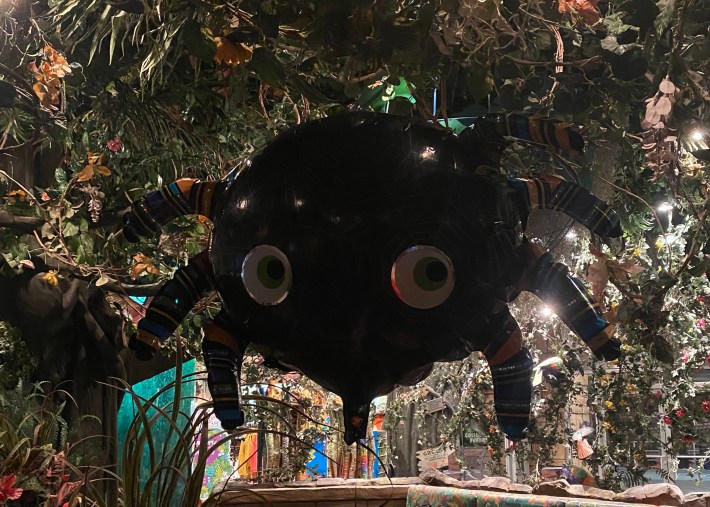
I forgot to mention that our dinner coincided with the Rainforest Cafe's early celebration of Halloween, which meant that the staff were all in costume, cobwebs dangled from the jungle vines, and this one amorphously spider-shaped balloon hovered by the entryway (amorphous in that the balloon appears to have four legs on the right side of its body and three on the left ... what happened?). When I plugged this fellow into iNaturalist, I figured the app would refuse to identify it at all. But to my surprise, iNaturalist not only responded with suggestions, but with an identification: The app was "pretty sure" this balloon was a human. Was it the big eyes? It also offered some alternative suggestions, including the solitary marine tunicate Phallusia nigra, the zebra tilapia, and a horse (just a regular horse). AI is famously often wrong, but I was admittedly baffled at iNaturalist's refusal to abstain from identifying a species when there was no species at all to identify. But maybe the app knew something I didn't. Did this balloon contain the ectoplasm of a haunted Victorian child? I had no proof it did not.
Nevertheless, still a staunch believer in the power of iNaturalist, I wanted to put the AI through one final test. Could it identify the most elusive species of them all?

This time, iNaturalist bravely, hesitantly, said it was "pretty sure" this organism was an ancestral or modern human of some sort. But you can never be too sure, and the AI included a list of suggestions, including a dog, a ferret, a Djungarian hamster, and a chinchilla. I suppose you can never really know your coworkers. But we at Defector are friends to all creatures, and I would happily break bread with any chinchilla, whether or not they can blog. As the four of us filtered out of the Rainforest Cafe, leaving behind literal plates of bones and passing a crocodile shrouded in either jungle mist or spooky Halloween fog (unclear which), I felt deeply unsure exactly where and what I was leaving behind. Whatever it was, it seemed endangered.
